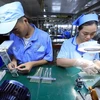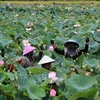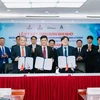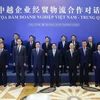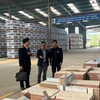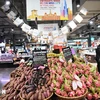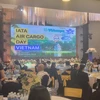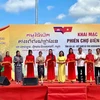Bao Loc in the Central Highland province of Lam Dong is famous nationwide for growing mulberries, raising silkworms and weaving silk.
Located at an altitude of over 800m, 190km from Ho Chi Minh City and 110km from Da Lat city, Bao Loc Plateau is cool all the year round with high rainfall, humidity and mist, suitable for growing mulberries and raising silkworms.
The “capital of sericulture" boasts large silk producers such as Bao Loc Silk Joint-Stock Company, A Chau Silk Joint-Stock Company, Kimono Company, Vietsilk Company and about 20 private silk production workshops.
In 2004, the Vietnam Sericulture Corporation (Viseri) joined hands with Matsumura Company (Japan) to establish three large factories in Bao Loc, including Silk Spinning Factory No. 4 with an annual capacity of 85 tonnes of silk cords and two factories producing silk for making ties and kimonos with an annual capacity of 486,000m and 480,000m respectively, opening a new development period for the sericulture sector in Bao Loc.
Bao Loc silk is produced with the modern technology of Japan and the Republic of Korea, so it is always superior in quality compared to other products of the same kind. The silk cords are very thin and velvety that help create beautiful glossy silk products, diverse in styles and designs, which are much sought after in both domestic and foreign markets.
At present, Bao Loc produces over 20 different categories, such as satin, crepedechine (CDC), jacquard, Habutai, oganza, Georgetee (GGT.Voal), Taffetas and visco mixed fabrics and cotton mixed.
Nguyen Tien Dung, former Deputy Director of Viseri, established Vietsilk Company after his retirement from a State-owned company. He recently installed 60 power-looms of weaving small-size jacquard cloth in the Japanese technology to make kimonos and 20 power-looms of producing silk lining for making kimonos.
“I believe that the brocade will bring high economic value because it is a high-grade product which is in great demand in developing countries,” said Dung who has a great zeal for Vietnam’s sericulture sector.
Vietsilk exports about four tonnes of brocade and silk per month to Japan, Singapore and Pakistan. In the past six months of this year, the company exported to Japan about 20 tonnes of brocade and silk of different kinds, worth nearly 2 million USD. In the coming years, Vietsilk will gradually increase the productivity for export.-VNA
Located at an altitude of over 800m, 190km from Ho Chi Minh City and 110km from Da Lat city, Bao Loc Plateau is cool all the year round with high rainfall, humidity and mist, suitable for growing mulberries and raising silkworms.
The “capital of sericulture" boasts large silk producers such as Bao Loc Silk Joint-Stock Company, A Chau Silk Joint-Stock Company, Kimono Company, Vietsilk Company and about 20 private silk production workshops.
In 2004, the Vietnam Sericulture Corporation (Viseri) joined hands with Matsumura Company (Japan) to establish three large factories in Bao Loc, including Silk Spinning Factory No. 4 with an annual capacity of 85 tonnes of silk cords and two factories producing silk for making ties and kimonos with an annual capacity of 486,000m and 480,000m respectively, opening a new development period for the sericulture sector in Bao Loc.
Bao Loc silk is produced with the modern technology of Japan and the Republic of Korea, so it is always superior in quality compared to other products of the same kind. The silk cords are very thin and velvety that help create beautiful glossy silk products, diverse in styles and designs, which are much sought after in both domestic and foreign markets.
At present, Bao Loc produces over 20 different categories, such as satin, crepedechine (CDC), jacquard, Habutai, oganza, Georgetee (GGT.Voal), Taffetas and visco mixed fabrics and cotton mixed.
Nguyen Tien Dung, former Deputy Director of Viseri, established Vietsilk Company after his retirement from a State-owned company. He recently installed 60 power-looms of weaving small-size jacquard cloth in the Japanese technology to make kimonos and 20 power-looms of producing silk lining for making kimonos.
“I believe that the brocade will bring high economic value because it is a high-grade product which is in great demand in developing countries,” said Dung who has a great zeal for Vietnam’s sericulture sector.
Vietsilk exports about four tonnes of brocade and silk per month to Japan, Singapore and Pakistan. In the past six months of this year, the company exported to Japan about 20 tonnes of brocade and silk of different kinds, worth nearly 2 million USD. In the coming years, Vietsilk will gradually increase the productivity for export.-VNA
